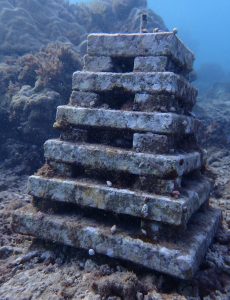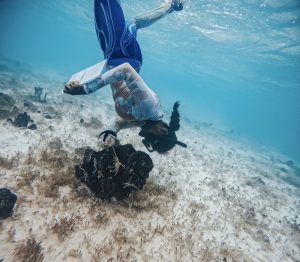When it comes to colour, ocean organisms exhibit an enormous amount of diversity. Some organisms, like Scorpionfish, demonstrate impressive camouflage in which neutral colours and texture interact to allow the organism to seemingly disappear within the reef or sea bottom. Other organisms stand out due to their colourful displays. For example, despite their small size, Fairy Basslet are impossible to miss due to their bright purple and yellow bodies.
But in ocean organisms, there can be even more layers to colour than just hue, saturation, and brightness. Sometimes colour glows, shines, and even appears to change when you or the organism moves. These curious colourations are often a product of phenomena known as iridescence, fluorescence and bioluminescence. Read on to learn more about these jaw-dropping appearances!

Our very own communications director and researcher, Lily Haines, observed a fantastic display of bioluminescence in Abaco several ago. It was about midnight, and Lily and the group of researchers had just surfaced from a night dive in which they hoped to see corals spawning. Unfortunately they had no luck and started to boat back to shore feeling rather defeated. However, a few minutes into the ride the crew was overtaken with awe as they gazed around at a glowing ocean! Lily conveyed, “It looked like the ocean was painted in stars. Stars above and stars below, for ten minutes the ocean mirrored the night sky. Plus, we saw 12 shooting stars that night! It was one of the most transcendental experiences of my life.”
At the time, the researchers didn’t know whether the glow was a product of algae or worms. What they did know, however, is that they were observing bioluminescence — the production and emission of light by a living organism due to chemical reactions. In the ocean, this “living light” can occur in jellyfish, ctenophores, algal blooms, squid and more. The exact purpose of bioluminescence is still a mystery for many organisms, though it may aid in communication, defence, luring prey and assist in reproduction in the absence of light.

Next up we have a phenomena that is just as breathtaking: fluorescence. Fluorescence is the absorption of light in one colour and the re-emission of light in another colour. This occurs in various marine organisms, including some anenomes and corals! However, fluorescence is not always obvious and may require specific lighting conditions. On a recent night dive in South Andros, our remote sensing and photogrammetry specialist Will Greene observed fluorescence first hand.

“Sometimes, during the day, you can see a few corals fluorescing, but the phenomenon really comes alive at night when you use a blacklight. When you shine UV light on a fluorescing coral, you almost can’t believe your eyes –it looks like something out of a sci-fi movie!”. In most cases, the shift in colour is due to the presence of proteins that change light that is received in the blue-ultraviolet range to green, red or blue.
But, what is the purpose of emitting different colours? For shallow water corals, the conversion of light is thought to protect their symbiotic micro-algae from harmful rays from the sun. In this way, fluorescence acts a bit light sunscreen! For deep water corals, the conversion of light actually does the opposite. The change in colour allows the light to penetrate deeper into the corals’ tissues, which increases the photosynthetic activity of the symbiotic algae! This is important where sunlight is scarce.
Finally we come to iridescence— a phenomenon in which colours appear to change based on the angle of viewing or angle of illumination. This happens when the structure of the fish scales, shells, or octopus skin causes light waves to combine with one another indifferent ways, resulting in a colour that instantaneously brightens and dims. Fish expert and Senior Scientist Krista Sherman reflects on this phenomenon,“One of my favourite things about diving or snorkeling on a reef is the stunning display of colours, and iridescence adds a wow factor that makes me really marvel at the beauty of nature. It’s something you’ll notice if you look into the eyes of balloonfish or the bodies of some reef fish species, squid and jellyfish.”
.jpg)
Iridescence in cephalopods occurs due to stacks of reflecting plates in their skin. These plates are called iridophores, and under different angles, they can create iridescent greens, blues, silvers and golds. For example, the Caribbean Reef Octopus appears modelled brown-white from some angles and iridescent blue-green from others.
In many fish, stacks of thin crystal plates in their scales and skin give them their iridescent shine. In juvenile YellowtailDamselfish, iridescence takes form as eye-catching blue spots all over their body! As the fish shifts to its adult phase, the blue spots concentrate in thehead and dorsal portion only.

We are amazed by the curious colourations of ocean organisms, whether that be camouflage, vivid colours, or phenomena such as the twinkle of bioluminescence, glow of fluorescence, and shine of iridescence.

A Year Later, Stranded Tug and Barge Still Scars Reef in Fowl Cays National Park–Residents Demand Accountability
A haunting aerial view of the grounded tug and barge in Fowl Cays National Park—still embedded in coral a year later, a stark reminder of the cost of inaction. Photo

Women Leading Mangrove Restoration in The Bahamas
Have you ever wondered who’s behind the scenes saving our environment, right in our own backyard? Picture a group of energetic, determined women rolling up their sleeves and diving into

Rewilding the Marls of Abaco: PIMS Plants 100,000 Mangroves and Counting in 2024
As the afternoon sun bathes the Marls of Abaco in golden light, Bahamian boat captain Willis Levarity–locally known as “Captain to the Stars”–stands ankle-deep in soft, warm mud. A broad

Unveiling Coral Reef Biodiversity: Insights from ARMS Monitoring Structures
An ARM teeming with new coral recruits and a diversity of marine life, highlighting reef recovery and biodiversity Understanding Coral Reef Biodiversity Most new PhDs in the natural sciences move

7 Key Takeaways from COP16: Confronting Coral Reef Challenges in a Changing Climate
United #ForCoral: Experts, advocates, and leaders from across the globe join forces at COP16 for the #ForCoral conference, hosted by the International Coral Reef Initiative. Together, they’re driving urgent action

Fieldwork Wrap-Up: Strengthening MPA Management in The Bahamas
Marine protected areas (MPAs) are critical tools in the conservation of marine species and habitats, safeguarding reefs, seagrasses, and mangroves that provide vital ecosystem services to coastal communities. At the



